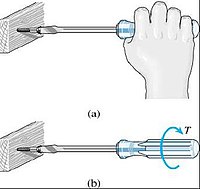
Photo from wikipedia
Abstract Photosynthesis is a critical component to understanding how CO2 uptake and vegetation productivity drives the terrestrial carbon cycle. Light use efficiency (LUE) is a key indicator of photosynthesis, which… Click to show full abstract
Abstract Photosynthesis is a critical component to understanding how CO2 uptake and vegetation productivity drives the terrestrial carbon cycle. Light use efficiency (LUE) is a key indicator of photosynthesis, which is determined by the most limiting/co-limiting environmental stresses such as nutrition, water, and temperature, restraining the photochemical reaction process across both space and time due to remote sensing offers a capability to relate changes in LUE with changes in the spectral characteristics of leaves through the photochemical reflectance index (PRI). The PRI is a narrow waveband index that responds with changes in xanthophyll-induced absorption feature at 531 nm. It remains challenging, however, to upscale PRI from leaf to canopy and ultimately to the landscape level due to physiological and structural factors such as leaf angle distribution, leaf area, canopy structure and pigment pool size as well as observational considerations such as sun-view geometry and background reflectance. As a result, understanding patterns of PRI and LUE across different climate-induced stress conditions and within age-induced vertical stand structures is helpful for improving our understanding how these relationships change over forested landscapes in anticipation of future airborne and ultimately satellite-based observations. In this study, we report on the use of the automated multi-angular spectro-radiometer (AMSPEC) and eddy-covariance techniques to examine how PRI and LUE varies at young (HDF88) and older (DF49) Douglas-fir sites. Results indicate that a strong relationship between bidirectional reflectance distribution function (BRDF) corrected PRI and LUE exists (DF49: R2 = 0.73; HDF88: R2 = 0.79). The overall LUE at the older, more structurally complex site was higher than at the younger, structurally simpler stand under a range of air temperature and light conditions. We used the standard deviation (SD) of light detection and ranging (LiDAR) return pulses to characterize canopy vertical structure of the site, and found that complex vertical structures (i.e., high SD) may contribute to a higher long-term averaged LUE (R2 = 0.87). While interesting we conclude the mechanism of the relationship between LUE and vertical forest structures needs to be further explored because of the key role internal and external shadowing has on light regimes with stands and thus vertical patterns of LUE varying across forest stands of different age.
Journal Title: Remote Sensing of Environment
Year Published: 2018
Link to full text (if available)
Share on Social Media: Sign Up to like & get
recommendations!